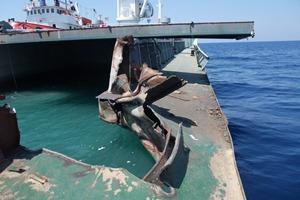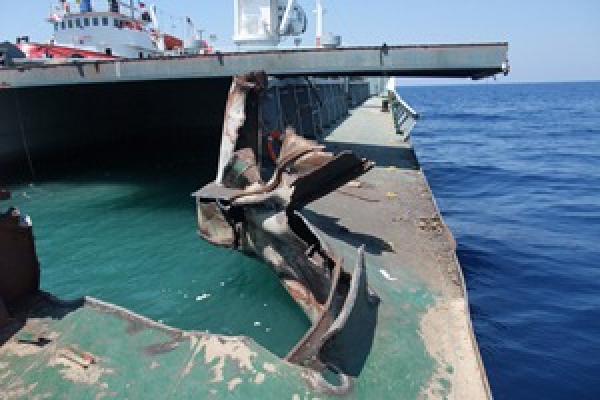
Steamship Mutual
Published: June 01, 2013

Bunge S.A. v Kyla Shipping Company Limited [2012] EWHC 3522 (Comm).
The “Kyla” was time chartered under an amended NYPE 1946 form dated 6 February 2009. The charter included, at clause 1, a continuing duty for owners to maintain the vessel in an efficient state during the currency of the charter. Furthermore, at clause 41, there was a continuing warranty requiring owners to maintain adequate H&M insurance up to the value of US$ 16,000,000.
During the charter the vessel was berthed at Santos, Brazil, when another vessel collided with her. There was no fault whatsoever attributable to the vessel. Owners gave notice of abandonment to their H&M underwriters insisting that the vessel was a constructive total loss as they believed the value of the repairs would outweigh the market value of the vessel. It was subsequently determined that the value of the repairs would have been of the order of US$ 9,000,000 and a reasonable estimate of the market valuation of the vessel at the time was US$ 5,757,000. After tendering notice of abandonment to H&M insurers owners informed the charterers that the cost of repairs would exceed the market value of the vessel and contended, therefore, that the charterparty was frustrated.
Charterers disputed that the charterparty was capable of frustration in these circumstances and the matter was referred to arbitration. Charterers insisted that there was a duty on owners to repair the vessel within the insured value and continue the charter. The sole arbitrator favoured owners’ arguments and found that there was a general principle that a charterparty will be frustrated in circumstances where the cost of repairs exceeds the sound market value of the vessel. The tribunal stated further that a very clear and express clause would be required in the charterparty to obligate the owner to repair in such circumstances and they did not consider clause 41 to constitute such a clause. An appeal to the Commercial Court was heard on a question of law.
The court reviewed the essential principles of the law of frustration. It highlighted that these are authoritatively summarised by Lord Radcliffe in Davis Contractors Ltd v Fareham Urban District Council [1956] A.C. 696 (“Davis Contractors”):
"... frustration occurs whenever the law recognises that without default of either party a contractual obligation has become incapable of being performed because the circumstances in which performance is called for would render it a thing radically different from that which was undertaken by the contract. Non haec in foedera veni. It was not this that I promised to do."
In addition, the court highlighted that the modern approach to the doctrine of frustration is exemplified in the judgment of Rix LJ in Edwinton Commercial Corporation & Anor v Tsaviliris Russ (Worldwide Salvage & Towage) Ltd (“The Sea Angel”) [2007] EWCA Civ 547. In that case Rix LJ described the modern doctrine of frustration as requiring a multi-factorial approach. In assessing whether frustration has occurred consideration must be given to many factors including the terms of the contract and the parties’ knowledge and expectations at time of contracting. These must be considered in reference to the nature of the supervening event (ie the casualty) and the parties’ reasonable expectations of performance in light of the new circumstances. He went further by saying that the “radically different” test established in Davis Contractors is important because it tells us that the doctrine of frustration should not be invoked lightly. However, Rix LJ cautioned that the “radically different” test should not be taken in isolation from the demands of justice. Consideration must be given to the interests of justice as a “reality check” when determining whether frustration should apply or not.
The court went on to consider the question of whether there is, in fact, an established general principle peculiar to charterparties that a charterparty will be frustrated where the cost of repairs exceeds the value of the ship. The court noted that the cases relied upon by owners could all be distinguished from the circumstances of the present case and particularly that none involved a charterparty that contained a continuing warranty concerning H&M insurance. The court concluded that the case law “should not be treated as establishing some inflexible rule that, where the cost of repairs exceeds the value of the vessel the charterparty will be frustrated...” The modern law of frustration encourages a more flexible approach that does not rely on one factor.
On a contractual analysis the court found that the existence of clause 41 precluded owners from contending that the casualty was not something that was contemplated by the parties and provided for in the charterparty. Clause 41 allocated to owners the risk that if a casualty occurred they are obligated to effect repairs within the insured value. Even if the Court accepted owners’ argument that there was a general principle that a charterparty is discharged when the repair costs exceed the insured value, the principle could not apply in this case in view of the specific continuing warranty as to H&M insurance.
Separately, owners’ argument that clause 16 of the charterparty relieved owners from any liability arising from “perils of the sea” did not excuse owners from their obligations under the charterparty to repair the vessel within the insured value.
In addition, applying the “reality check” test advocated by Rix LJ in “The Sea Angel” did not lead to the conclusion that finding the charterparty capable of continuation would be contrary to the interests of justice. The court reasoned that there was nothing unjust in holding owners liable to repair the vessel within the insured value, as provided for under clause 41 of the charterparty.
Owners had attempted to induce frustration of the charterparty by electing not to repair the vessel. The casualty did not make performance of the charterparty radically different from that to which owners had agreed. Clause 1 required owners to maintain and repair the vessel and clause 41 contained a warranty that owners would have H&M insurance to the value of US$ 16,000,000, which was sufficient to cover the cost of repairs. On this basis the charterparty was not frustrated and the appeal was allowed.
Article by Gareth Thompson


